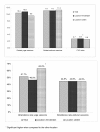A process evaluation of a worksite vitality intervention among ageing hospital workers
- PMID: 21663610
- PMCID: PMC3127968
- DOI: 10.1186/1479-5868-8-58
A process evaluation of a worksite vitality intervention among ageing hospital workers
Abstract
Background: The process evaluation of the Vital@Work intervention was primary aimed at gaining insight into the context, dose delivered, fidelity, reach, dose received, and participants' attitude. Further, the differences between intervention locations were evaluated.
Methods: Eligible for this study were 730 workers, aged ≥ 45 years, from two academic hospitals. Workers randomised to the intervention group (n = 367) received a 6-months intervention consisting a Vitality Exercise Programme (VEP) combined with three visits to a Personal Vitality Coach (PVC), aimed at goal setting, feedback, and problem solving. The VEP consisted of a guided yoga session, a guided workout session, and aerobic exercising without direct face-to-face instruction, all once a week. Data were collected by means of a questionnaire after the intervention, attendance registration forms (i.e. attendance at guided VEP group sessions), and coaching registration forms (filled in by the PVCs).
Results: The dose delivered of the yoga and workout sessions were 72.3% and 96.3%. All PVC visits (100%) were offered. The reach for the yoga sessions, workout sessions and PVC visits was 70.6%, 63.8%, and 89.6%, respectively. When taken these three intervention components together, the reach was 52%. This differed between the two locations (59.2% versus 36.8%). The dose received was for the yoga 10.4 sessions/24 weeks and for the workout 11.1 sessions/24 weeks. The attendance rate, defined as the mean percentage of attended group sessions in relation to the total provided group sessions, for the yoga and workout sessions was 51.7% and 44.8%, respectively. For the yoga sessions this rate was different between the two locations (63.2% versus 46.5%). No differences were found between the locations regarding the workout sessions and PVC visits. Workers attended on average 2.7 PVC visits. Overall, workers were satisfied with the intervention components: 7.5 for yoga sessions, 7.8 for workout sessions, and 6.9 for PVC visits.
Conclusions: The implementation of the intervention was accomplished as planned with respect to the dose delivered. Based on the reach, most workers were willing to attend the guided group sessions and the PVC visits, although there were differences between the locations and between intervention components. Overall, workers were positive about the intervention.
Trial registration: Trial registration NTR1240.
Figures




References
-
- Strijk JE, Proper KI, van der Beek AJ, van Mechelen W. The Vital@Work Study. The systematic development of a lifestyle intervention to improve older workers' vitality and the design of a randomised controlled trial evaluating this intervention. BMC Public Health. 2009;9:408. doi: 10.1186/1471-2458-9-408. - DOI - PMC - PubMed
-
- Shirom A. In: Work Engagement: recent developments in theory and research. Bakker A, Leiter M, editor. New York, NYC: Psychology Press; 2010. Feeling energetic at work: On vigor's antevendents.
-
- McNair DM, Lorr M, Droppleman LF. Manual for the profile of mood states. San Diego: Educational and Industrial Testing Service; 1971.
Publication types
MeSH terms
LinkOut - more resources
Full Text Sources

